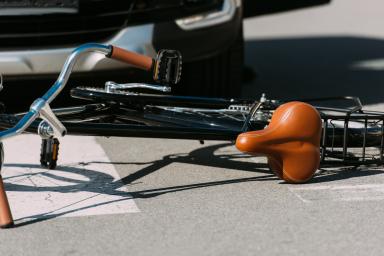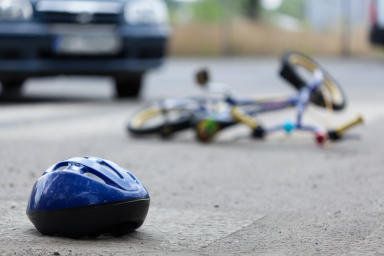Pennsylvania Bicycle Laws

Commuters and advocacy groups alike have cited Pennsylvania's cities (and even its state college) as being bike-friendly, following continuous improvements to the legal and physical infrastructure for its biking community. In its whole, Pennsylvania placed 12th in The League of American Bicyclists’ rankings for bike-friendly U.S. states in 2022, with the organization recognizing the Keystone State’s bicycling-dedicated state funding, policies and programs that promote cycling and other forms of active transportation, and legislation and law enforcement that keep an eye out for bike riders.
Sections dedicated to pedalcycles (which is the Pennsylvania Vehicle Code’s legal term for bicycles) guide the state’s Department of Transportation in outlining the rules of the road for bicycle riders, as well as the traffic accommodations and legal protections they are entitled to. In this article, we’ll outline the salient provisions of the statutes for both the everyday bike user on Pennsylvania roadways and the leisure trail rider taking advantage of the state’s diverse geography.
Bike Riders’ Right to Pennsylvania Roads
Pedalcycle operators in Pennsylvania have the same right to the road as motor vehicle drivers, meaning bicycles should have access to roadway space that will allow for their safe and lawful operation. Since bicycles are considered vehicles under state law, they have to follow traffic regulations, and bike riders can be issued citations for violating traffic laws the same way other motorists are.
Bikers, ideally, should be accorded traffic safety and roadway considerations commensurate with their on-road vulnerability and, at times, to make up for road infrastructure that was historically designed for motor vehicles.
Sharing the Road with Motor Vehicles
In Pennsylvania, it is the responsibility of the car driver (and not the cyclist’s) to ensure a distance of four feet between their vehicle and the bicycle they want to overtake. Cars must overtake to the left of the bicycle at a prudent and safe speed.
In no-passing zones, cars are allowed to overtake bicycles, but they must exercise due care, overtake to the left at a reasonable speed, and maintain the 4-foot distance. This is to minimize delays in areas like two-lane rural roads. A bike rider being overtaken does not need to move their vehicle to the road shoulder or further to the right if it’s not practical to do so.
Cars are not allowed to cut off the path of bicyclists when turning right, just as they’re not allowed to interfere with the path of another car. This maneuver, sometimes called a right hook, poses great danger to cyclists, and a collision will throw them off their seats. The correct action is to fall behind a bicycle and make the right turn from there.
Preventing Dooring Incidents
Pennsylvania has provisions against dooring, or opening a car door onto the path of another road user (like bicycle riders and pedestrians). No one should open their car door until it’s reasonable and safe to do so, being prudent that the door will not interfere with traffic flow (including bicycle traffic) or hit anyone. A violation of this is a summary offense.
PennDOT advises bike riders to keep a distance of 4 feet between their path and a line of parked vehicles to lessen the likelihood of being doored by careless motorists.
Where You Can Ride Your Bike in Pennsylvania
Bicycles may be operated on the shoulder of the road, keeping in the same direction as traffic. However, this does not mean they must remain on the shoulder. Bikes can generally be ridden on traffic lanes and must meet the following conditions:
Bikes may be ridden in the right-most travel lane on a multilane highway.
A bike may be ridden in the right lane of a two-lane road.
On a road with no center line, a bike may be ridden anywhere on the right side of the road.
Cycling on the shoulder or in the travel lane is entirely up to the individual cyclist; however, their decision may be influenced by factors such as the amount and speed of oncoming traffic, the condition of the shoulder or travel lane, their intended route, and other safety considerations.
Sidewalk and Crosswalk Use for Bike Riders
Bicycles can be operated on most Pennsylvania sidewalks, but cyclists must remember that pedestrians retain the right-of-way. Before passing or overtaking a pedestrian, a bike rider must give a clear warning, like an audible signal, to prevent a collision.
Bikes, however, generally cannot ride on sidewalks in business districts, unless an official traffic-control device clearly indicates that they are allowed to. Bikes cannot use sidewalks if there is a designated bike lane along the same road.
Motor vehicles are not required to yield to bicycles being ridden on crosswalks, since the bicycle is considered a vehicle here. A workaround for crossing safely across travel lanes is to dismount the bicycle, and walk your bicycle as a pedestrian.
Mandatory Helmet Use for Children
Pennsylvania laws give the utmost care to children who may just be getting into bicycling, including instilling the discipline of habitual safety gear use. In the state, bike riders under the age of 12 are required to wear protective bicycle helmets while on a bike, whether they’re operating the bike or a passenger in a bike-towed trailer. Helmets must fit properly and fastened securely while in use. Helmets must adhere to nationally recognized standards, such as those that have received approval from the Snell Memorial Foundation, the American Society for Testing and Materials, and the American National Standards Institute.
Penalties for violations of this helmet law for children are more rehabilitative than punitive.
Judges will dismiss citations or tickets received by minors if, before their hearing, their guardian acquires a helmet that meets safety standards. A receipt sent to the judge for new purchases will suffice as proof; if the helmet was transferred from another owner, a notarized letter will suffice. Refusal to purchase a helmet at this stage requires the parent to pay up to $25.
Helmet Use Violations Inadmissible in Court
Pennsylvania legislation, however, considers the non-use of a safety helmet inadmissible evidence in civil actions. Should a personal injury lawsuit be filed, an individual not wearing a helmet while biking cannot be used to prove contributory negligence, and neither should it be heard at court or the jury be given the impression that going biking without a helmet is a legal violation.
Required Bicycle Equipment in Pennsylvania
Quite a bit of the fun of owning a bicycle is decking it out, but don’t forget to include fitting the legally required safety equipment and features on your ride.
Visibility is key when you’re a vulnerable road user sharing the cities with motor vehicles, so lamps are a must. You need to see the road clearly, and other motorists must be very aware of your presence and not cut into your path, especially at night when car-bike crashes occur most frequently. When riding between sunset and sunrise, a biker must use a front lamp that emits a white light to illuminate the path ahead; a rear lamp that emits a red light; and amber reflectors on each side of the bike. These lamps must be visible from at least 500 feet away.
Bicycles must also be fitted with brakes that are capable of stopping the bike 15 feet from a speed of 15 mph on dry and level pavement. As for audible signal devices like bells, some municipalities require them while others do not, but statewide rules require these devices to be audible for a distance of at least 15 feet. Your bike, however, cannot be equipped with a siren.
In addition to the above legal requirements for equipment, the Pennsylvania Department of Transportation has the following bicycle safety gear recommendations: Consider wearing bright clothing when taking your bike out, and keep a pump, a patch or repair kit, and a spare tube when riding for on-the-go maintenance.
Is Pennsylvania a No-fault State for Bike Accidents?
Pennsylvania is a “choice no-fault” state, giving vehicle owners the option between fault-based insurance (full tort insurance coverage) and no-fault insurance (limited tort insurance coverage).
The policyholder has unrestricted rights to file a lawsuit against the negligent party if they choose a full tort coverage option. They also have unrestricted rights as far as obtaining financial compensation from the responsible party for injuries, no matter their severity, non-economic damages, and even possible punitive damages.
Out-of-pocket medical expenses and other losses are still recoverable under the limited tort coverage for policyholders. However, they can't recover payments for pain and suffering unless they sustain "serious" injuries.
How Much Can Someone Sue for a Bicycle Accident in Pennsylvania?
In Pennsylvania, the amount of compensation an individual can legally pursue following a bicycle accident varies based on injury severity, the financial setbacks they face due to the incident, and the accident’s effect on the victim’s life. There are typically two types of damages sought: economic and non-economic.
Economic damages typically include coverage healthcare bills, property damage, and income loss. Non-economic damages, on the other hand, serve to offset intangible losses, such as emotional distress, loss of enjoyment of life, and pain and suffering (which can sometimes be as high as five times the amount of economic damages).
Poor road conditions can contribute to bicycle accidents, and courts may hold government organizations responsible for maintaining traffic safety. Keep in mind that there is a $500,000 damages cap that applies for cases filed against local government entities in Pennsylvania.
What Is Pennsylvania’s Statute of Limitations for Bicycle Accident Lawsuits?
Pennsylvania sets a two-year statute of limitations for bicycle accident cases. A lawsuit — for property damage or for physical injuries resulting from the alleged negligence of another party — must be filed within two years of the date of the accident. Should the bicycle accident victim be a minor at the time of the accident, they have up to two years until they turn 18 to file a lawsuit. Families of victims of wrongful death also have two years from the date of the victim's passing to mount a claim against a negligent party.
Legal Resources for Pennsylvania Bicycle Accident Victims
Pennsylvania Bar Association Lawyer Referral Service
Through its lawyer referral service, the state bar association assists individuals in finding the right attorney for their legal concerns. The process starts by filling out the online form and providing an explanation of the legal issue. The applicant will be referred to a lawyer suited to handle their case. They can then contact the lawyer for an initial 30-minute consultation costing no more than $30. You may also access the state's local bar lawyer referral services list.
Pennsylvania Bar Association Pro Bono Program
This free legal aid service aims to help underprivileged citizens who have been in a bicycle accident and need legal assistance. Those who seek legal professionals should fill out the PBA Pro Bono Program Legal Assistance Request Form. They can also look at the County Pro Bono Map for additional information about the volunteer lawyer activities in their area. Individuals seeking free legal advice may also contact the Pennsylvania Legal Aid Network.
Commonwealth of Pennsylvania Driver's Accident Report
If law enforcement did not investigate a traffic accident or if there was injury, death, or property damage, bike operators must file a Driver's Accident Report (AA-600) form with PennDOT within five days of the collision. The report's objective is to collect data that can be used to develop strategies for accident prevention and reduction.
Pennsylvania Department of Transportation
The Pennsylvania Department of Transportation offers information on the state’s biking laws and protective measures for pedalcycle operators. Its knowledge base covers bicycle rules, road-sharing instructions, and important safety recommendations for bikers.
Pennsylvania Bicycle Driver’s Manual
Prepared by the Pennsylvania Department of Transportation, this manual outlines sections of the Pennsylvania Vehicle Code that apply to bicycle operators. It has direct references to salient legislation, as well as short explainers that translate the laws into simple English. It also has chapters regarding bike safety and regulated biking etiquette.
The Bicycle Coalition of Greater Philadelphia
The Bicycle Coalition of Greater Philadelphia, a not-for-profit organization, has dedicated over half a century to improving the conditions for cyclists in Philadelphia and its neighboring counties in Pennsylvania and New Jersey. The organization prioritizes campaigns for enhanced street safety measures, supports the development of bike paths, and pursues a Vision Zero strategy that aims to eliminate all traffic-related deaths and injuries across all means of transit.
Expertise.com StaffAuthor
Step into the world of Expertise.com, your go-to hub for credible insights. We don't take accuracy lightly around here. Our squad of expert reviewers, each a maestro in their field, has given the green light to every single article you'll find. From rigorous fact-checking to meticulous evaluations of service providers, we've got it all covered. So feel free to dive in and explore. The information you'll uncover has been stamped with the seal of approval by our top-notch experts.




